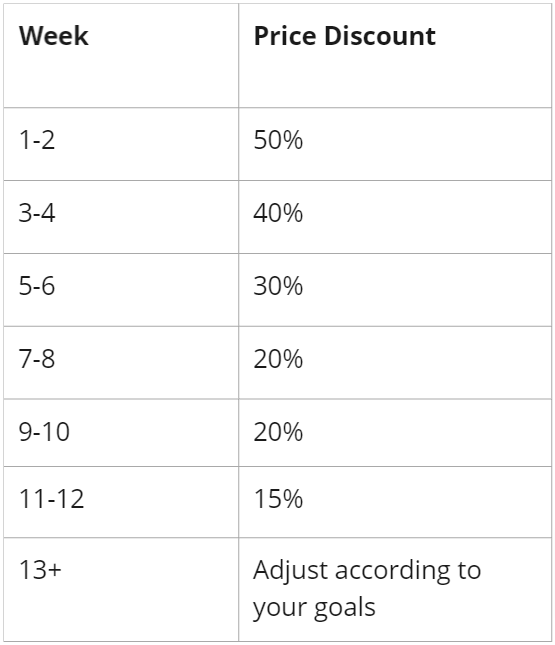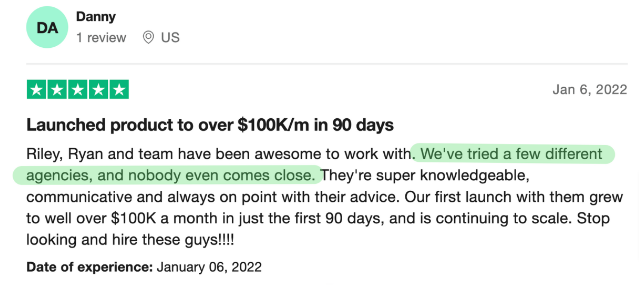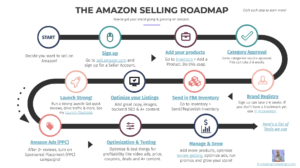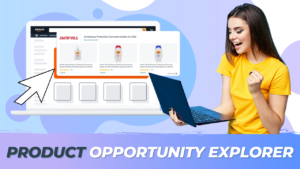The Complete Amazon FBA Product Launch Playbook
Let’s talk about product launches on Amazon. Pulling off a successful Amazon FBA product launch takes more than posting your product in the marketplace and running PPC ads. There are a lot of moving parts you should consider before launching your product. In this blog post, I’ll reveal the Amazon FBA product launch playbook that I’ve used to launch my products and clients’ products for years successfully. This guide will be helpful if you are:
- A brand launching on Amazon
- A seller who recently launched but is not getting any traction
- Someone who has been on Amazon for a while and needs to re-launch slow products
Let’s get into it!
Step 1: Create a Million-Dollar Listing
A fully optimized listing is the foundation of any successful Amazon FBA product launch. Your listing is your virtual store, so you need to do some pre-launch housekeeping. Before sending traffic to it, ensure your listing has the highest possible conversion rate. You’ll leave a lot of money on the table if you don’t optimize your listing before launching your product. Here’s my framework for making a fully optimized Amazon product page.
Pillar 1: Get Good Photography
Good photography is the bedrock of your brand, and this is not an area you want to be penny-pinching. Invest as much as you can in professional photography. I recommend Soona for product photography. They have a package called Amazon A+ Premium Pack that comes with six photos, four infographics, a full-body model, and a 30-second video for $999. You should check them out.

Soona Amazon product photography.
Other resources worth considering are:
Title Brand Management: – They offer brand management services for consumer goods.
AMZ Conversion Pages: This is our creative agency that offers complete listing design services. Our team includes Senior copywriters, designers, and SEO experts.
Pillar 2: USP-Based Messaging
The key to Amazon is focusing on why you are UNIQUE and BETTER than your competition. You must highlight your unique selling proposition (USP) during your Amazon FBA product launch. You see, Amazon shoppers don’t need to be convinced they need the product. They have already searched for it! Shoppers are coming in with high buyer intent. They need to be convinced why they should order your product instead of the other options on Amazon. It’s a different sales pitch than your website, social media, or cold traffic
Pillar 3: Videos
You need three types of videos for a successful Amazon FBA product launch:
- Main video: This is your commercial video
- User-generated video: These are the videos customers or influencers record, either reviewing the product or using it.
- Long-form videos: The easiest and most effective way to make a long-form product video is for you, the product creator, to talk about the product for 5-10 minutes as if you’re telling a friend about it.

How to upload videos to Amazon listing.
Make sure to add your videos in the videos section above the reviews section. Upload videos in reverse order such that you add your best video last so it appears first on the left.
Pillar 4: Infographics
Infographics help you highlight your USP. Here are the considerations for effective infographics:
- The 3-Second Rule: Set up your infographics so a customer understands the information in 3 seconds.

Amazon listing infographics.
- Us Vs. Them: This helps compare your products to the competition and promotes USP-based messaging. Talk about one benefit or feature at a time and sell with large headlines.

Amazon listing comparison infographic.
Pillar 5: Premium A+ Content
Your Premium A+ Content section is the largest area on your listing. This is where you put the most prominent images and high-definition videos. Use at least one video module in your Premium A+ Content. To unlock Premium A+ Content, you must have at least five regular A+ Content approvals in the past 12 months. A simple hack to this is duplicating your A+ Content 5 times, saving it as a draft, and submitting it five times. Your Premium A+ Content should be unlocked in 7 days.
Pillar 6: Premium Look and Feel
Invest in making your brand look and feel like a $100 million brand. It will pay dividends in the long term. My creative agency, AMZ Conversion Pages, specializes in designing high-converting pages. You can hire us to create a premium brand for you on Amazon.

Amazon product paged creative Agency.
Step 2: Get Reviews Fast
We’ve found that a successful launch occurs when we get 30 reviews in 30 days. Let’s explore strategies and resources to hit the 30 reviews in 30 days.
Amazon Vine Reviews

Amazon Vine reviews.
The first thing you need to do is enroll in Amazon Vine Reviews and aim to get about 10-30 reviews based on your inventory. Don’t start advertising with Amazon PPC until you have at least two reviews.
Use FBA Reviews Product Testers

FBA reviews.
Since Vine has a 30 reviews cap and they aren’t guaranteed, you need to find additional methods to get reviews. Product tester sites come in handy for getting the first batch of reviews. I use FBA Reviews. You send products to testers, and they review them. Technically, you aren’t buying the review because it states that the review isn’t required. Is it against Amazon ToS? No, but it operates in a grey area. I’ve used it several times with no issues but proceed at your own risk.
Turn on Request Review Automation in Helium 10
Here’s how you automate your review requests on Helium 10:
- Sign up to Helium 10
- Go to Follow Up → Email Automation → Turn on Request a Review → New Automation → Request a Review.

Helium 10 review automation.
3.By default, Helium 10 will automatically send a review request 12 days after placing the order. That timeframe is fine for most products, but if you’re selling products like supplements, you may need to adjust the wait time to around 30 days to give the customer time to see some results.

How to request a review with Helium 10.
Use Insert Cards + GetReviews.AI
Insert cards with a QR code linking to a GetReviews survey, which can help you get many reviews on your product page. This strategy requires you to give the customer some incentive, although you have to state that a review isn’t required. It operates in a grey area as far as Amazon’s terms of service are concerned.
You should set review milestones to track your progress during your Amazon FBA product launch. The first milestone is 30 reviews in 30 days. From there, you should target getting to 100 reviews and then focus on getting to 1000 reviews with an average rating of 4.3. Once you get here, your product will be successful.
Click here to check out our free ultimate Amazon reviews guide!
Step 3: Sale Price Strategy
Starting on sale is one of the best Amazon FBA product launch pricing strategies. How much of a discount you give depends on your goals. So, why is a discount so important during launches?
For starters, you won’t be able to get traction if you start at your regular price. You want to start as low as you’re comfortable with. If possible, the price should be lower than the top five ranked sellers. Even if you price lower by $1, you will attract sales from price shoppers, and much of Amazon is price shoppers. Don’t try to make profits right out the gate during a product launch. Focus on market penetration instead.
Let’s look at some approaches you can use for your sale price strategy:
Deep Initial Discount
One pricing strategy you can use is to offer a deep discount at first and then raise it in increments, as shown in the image below.

Amazon product launch pricing strategy.
You start at 50% off and then raise by 10% every two weeks. When you do this, you pay less rebate cost and get a high conversion rate because of the lower price. The drawback is that you won’t get a strikethrough price because it’s not the lowest price in 30 days.
Reviews-based Pricing Approach

Review-based Amazon pricing strategy.
Here, you apply a decent discount of, say, 20% off when you have zero reviews, then enroll in Vine reviews. When you have about five reviews, start advertising on PPC while maintaining the 20% discount. Once you have 30 reviews, you lower the price to 30% off to get a strikethrough price, which helps with conversion. At this point, your conversion rates should be good, and you can start pushing hard for ranking.
Week-by-Week Pricing Approach

Review-based Amazon pricing strategy.
Here, you apply a decent discount of, say, 20% off when you have zero reviews, then enroll in Vine reviews. When you have about five reviews, start advertising on PPC while maintaining the 20% discount. Once you have 30 reviews, you lower the price to 30% off to get a strikethrough price, which helps with conversion. At this point, your conversion rates should be good, and you can start pushing hard for ranking.
- What’s the daily sales velocity?
- How are my inventory levels?
- How’s my conversion rate?
- How’s my ranking?
Evaluate performance weekly, balancing these factors as shown in the chart above and adjusting the price accordingly.
Step 4: Run Amazon PPC Ads
Amazon is “pay to play,” so PPC ads are crucial to a successful Amazon FBA product launch. If I’m being honest, I’ve never seen a product launch work without PPC ads. Amazon PPC ads have no “set it and forget it” strategy. You must test, test, and keep what’s best. Here are some considerations when running PPC ads:
- Goals: Assess how aggressive you want to be with PPC ads and your risk tolerance, then determine how long you can break even. This will guide your PPC strategy.
- Budget: While being cautious with your budget is understandable, you should avoid underspending if you want to gain traction. We recommend testing at $100 a day to gather data and optimize
- Ad Placement: Top-of-search (TOS) placement is expensive, but it’s ideal for Amazon FBA product launch because that’s where you gather most data fast. If you perform well at TOS, your organic rank will skyrocket.
- Keyword Strategy: Use single keyword campaigns, also called “Alpha Campaigns.” This is where you set up campaigns around your main keywords.
Here is an image of the campaign structure we use during launches. PPC advertising itself is extensive, so I prepared this PPC crash course to give you a better understanding of Amazon PPC advertising.

Amazon PPC ads campaign structure.
In general, you’ll need to check your PPC daily during launch, then every other day, and eventually, weekly. Add negative keywords and optimize placements and bids every week to get the most out of your campaigns.
Step 5: Keyword SEO
Keyword SEO is about ensuring your content contains the right keywords so your products rank on Amazon. Here’s how you lay the foundation for keyword SEO for your Amazon FBA product launch:
- Do keyword research on Helium 10
- Write the title and bullet points with Helium 10 Listing Builder
- Add your backend search terms
- Fill out all backend attributes and metadata
- Add image keywords (alt text)
- Publish a text module in A+ Content containing all your Tier I, II, and III keywords and let it sit for 15 days so it indexes in Google.
Keyword SEO Basics
I split our keyword SEO basics into primary and secondary actions you need to take to improve your Amazon ranking.
Primary Actions
Here, you’ll focus on your title and bullet points. Ensure your primary keyword is in the title, and make it easy for a shopper to understand the title in three seconds. Basically, keep it short and sweet. Do the same for your bullet points. Add your primary keyword and Tier I, II, and III keywords. Make sure your bullet points are easily skimmable.
Secondary Actions
For the secondary actions, you’ll add keywords as alt text in your product images and A+ Content images. Next, you’ll deploy the three-phase 90-day SEO strategy.

Three-phase Amazon SEO strategy.
Here is a free detailed breakdown of the three-phase SEO strategy.
Step 6: External Traffic
Sometimes, PPC advertising alone isn’t enough to get you on page one of Amazon SERPs. In that case, you need to drive external traffic to your listing to get you a boost in sales and ranking. If you don’t do this, you risk having an unsuccessful Amazon FBA product launch. Let’s look at the easiest ways of driving external traffic to your listing
Rebate and Giveaway Sites
This is the easiest source of external traffic and offers the most bang for your buck. We use Rebaid.com for rebates and ViralSweep for sweepstakes. You can check them out.
Social Media
If you have a following, marketing your product on social media makes sense. Tell your followers about your upcoming launch, and promote it on your socials when you do launch. If you want to use influencers, check out Social Cat for micro-influencers and TikTok Creator Marketplace for TikTok creators.
Email Marketing
If you have a mailing list, do a drip email campaign leading up to the launch and during the launch. Offer your subscribers a discount code that expires in 24-48 hours. We use Klaviyo for email services. Here is an email template you can use to promote your Amazon FBA product launch to your email subscribers:
“Hello fans! We just launched this product on Amazon and want some fast feedback. The first 50 people can grab it for a whopping 40% off for the next 24 hours! Just reply to this email, and we’ll send your coupon code ASAP. First come, first served!”
You can use this template for social media as well.
PS: Whatever you do, don’t run out of stock in the middle of your Amazon FBA product launch. If you do, you’ll need to re-launch to improve your ranking.
Launch Your Products Like a Pro!
Amazon FBA product launches can be complex, especially for beginners. This guide equips you with all the information you need to launch successfully. Just ensure you go in ready with all the required tools, and you’ll be ready to go. If you’d like us to help you with your product launch and Amazon management, be sure to contact us so we can chat.
Download your free Amazon FBA Product Launch Miro Board here.
LinkedIn Post Copy

If you’ve struggled with Amazon product launches in the past, this post is for you.
Amazon product launches can be complex when you don’t have a working strategy. That’s why I’m giving you a behind-the-curtain look at my product launch strategy, which I use to launch my products and clients’ products successfully. This is the same strategy we used to launch and scale Danny’s product to $100k/month in 90 days.
Check out the link in the comments!





